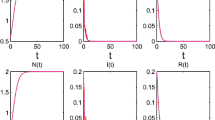Abstract
The spatial spread of a disease in an SIRS epidemic model with immunity imparted by subclinical infection on a population has been considered. The incidence rate of infection and the rate of immunization are both of nonlinear type. The dynamics of the infectious disease and its endemicity in local and global sense have been investigated.
Similar content being viewed by others
References
R. M. Anderson and R. M. May,Infectious Diseases of Humans: Dynamics and Control, Oxford University Press, Oxford, 1992.
R. M. Anderson,Mathematical studies of parasitic infection and immunity, Science Vol. 264 (1994), 1884–1886.
W. S. Burnside and A. W. Panton,The Theory of Equations, S. Chanda and Company Ltd, New Delhi, 1990.
V. Capasso and G. Serio,A generalization of the kermack-mckendrick deterministic epidemic model, Math. Biosci. Vol. 42 (1978) 41–61.
M. M. Denn,Stability of Reaction and Transport Processes, N. J. Englewood Cliffs, Prentice Hall, 1975.
Asit K. Ghosh and P. K. Tapaswi,An SIRS epidemiological model with immunity caused by low level of infection, Cybernetica Vol. XXXVIII (1995) No. 2, 153–168.
Asit K. Ghosh, J. Chattopadhyay and P. K. Tapaswi,Immunity boosted by low level of exposure to infection in an SIRS model, Ecolog. Modell. Vol. 87 (1996), 227–233.
W. S. C. Gurney and R. M. Nisbet,The regulation of inhomogeneous populations, J. Theor. Biol. Vol. 52 (1975), 441–457.
H. W. Hethcote, H. W. Stech and P. van den Driessche, P.,Nonlinear oscillations in epidemic models, SIAM J. Appl. Math. Vol. 40 (1981), 1–9.
F. Lara-Ochoa and P. Bustos,Density dependent diffusional model of an infective population, BioSys. Vol. 24 (1990), 223–238.
F. Lara-Ochoa and P. Bustos,A model for aggregation-dispersion dynamics of a population, BioSys. Vol. 25 (1990).
W. M. Liu, S. A. Levin and Y. Iwasa,Influence of nonlinear incidence rates upon the behaviour of SIRS epidemiological models, J. Math. Biol. Vol. 23 (1986), 187–204.
W. M. Liu, H. W. Hethcote and S. A. Levin,Dynamical behaviour of epidemiological models with nonlinear incidence rates, J. Math. Biol. Vol. 25 (1987), 359–380.
J. D. Murray,Mathematical Biology, Springer-Verlag, Berlin, 1989.
A. Okubo,Diffusion and Ecological problems: Mathematical Models, Springer-Verlag, Berlin, 1980.
Author information
Authors and Affiliations
Corresponding author
Rights and permissions
About this article
Cite this article
Ghosh, A.K., Chattopadhyay, J. & Tapaswi, P.K. An SIRS epidemic model on a dispersive population. Korean J. Comput. & Appl. Math. 7, 693–708 (2000). https://doi.org/10.1007/BF03012279
Received:
Revised:
Published:
Issue Date:
DOI: https://doi.org/10.1007/BF03012279




